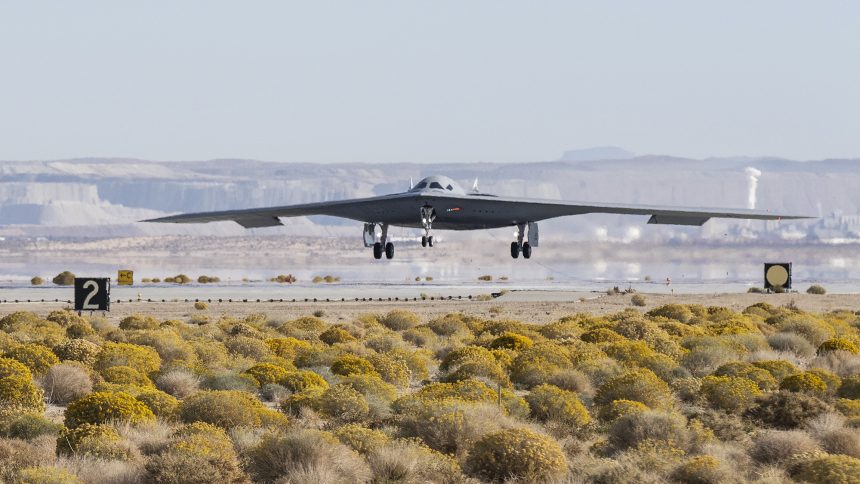Speaking at the Black Hills Defense & Industry Symposium, U.S. Air Force and Northrop Grumman officials said their next generation bomber is ‘close’ to being ready to enter service.
The Black Hills Defense and Industry Symposium was held on Apr. 9 and 10, 2025, in Rapid City, South Dakota, bringing together military and industry leaders along with state officials. Nikki Kodama, Vice President and Program Manager of B-21 Production at Northrop Grumman, was among those in attendance.
Commenting on the status of the next generation bomber program, for which Ellsworth Air Force Base, 10 miles outside of Rapid City, will be the first operational base, Kodama said: “Right now we are scaling in our production.” Northrop Grumman were awarded the second low-rate initial production contract for the Raider late in 2024 and more recent reports have suggested that production is under budget and ahead of schedule.
Personnel at Ellsworth AFB have been mentioned as expecting the B-21’s arrival sometime in the mid-2020s. However, since we are already in 2025, this statement is open to interpretation as it could imply a timeframe ranging from the mid- to late 2020s, or potentially even the mid-2030s. Additionally, we cannot rule out the possibility that one of the six airframes reported to be at various stages of production might be delivered to Ellsworth instead of Edwards.
I received a briefing on the new B-21 Bomber program. It is being built ahead of schedule and on budget. It will be a game changer for USAF for decades. pic.twitter.com/9AHr59BKNv
— Rep. Don Bacon 🇺🇸✈️🏍️⭐️🎖️ (@RepDonBacon) February 26, 2025
Kodama was joined by Colonel Brian Buscher, Commander of the 28th Operations Group and its two squadrons of B-1B Lancers. The unit’s aircraft recently began a 10 month detachment to Grand Forks AFB in North Dakota, allowing work to be carried out at Ellsworth in preparation for the B-21’s arrival.
Buscher and Kodama were equally clear in reinforcing the leap forward in capability that will be offered by the B-21 Raider. “This is a game changer,” claims Buscher. “This is not B-2 or 2.0. This is an absolute revolutionary change into the sixth-generation domain that is completely dominated by new technologies. It’s exciting to be a part of it.”
Kodama added “When we talk about that sixth-generation technology in aircraft, it’s about this open architecture that’s going to allow us to enable rapid upgrades in capability. We’re talking anything from new weapons to software updates that will allow us to keep up with that evolving threat.”.
The B-21’s arrival at Ellsworth is predicted to draw 1,500 U.S. Air Force personnel to the base, leading to an expected increase in the area’s overall population of 4,000. A new school is in the works for the local district to accommodate this increase, which is largely due to the family members of serving personnel. Fellow B-1B Lancer base Dyess AFB, Texas, and Whiteman AFB in Missouri, home of the B-2 Spirit, are also slated to become B-21 Raider bases.
Some cool B-21 renderings making the rounds on Twitter today. First saw it from @philewing and shows Raiders at Dyess, Whiteman, and Ellsworth. pic.twitter.com/U7Sn52mMTl
— Jeff Martin (@Jeff_MartinCA) January 31, 2020
Since its widely publicized unveiling in 2022, at least one pre-production airframe has been undertaking a flight test program, with three airframes known to be actively in use for testing. The second and third pre-production vehicles are reportedly used exclusively for static ground tests.
A B-21 #Raider conducts flight testing, which includes ground testing, taxiing, and flying operations in California. (U.S. Air Force, Sept. 2024) pic.twitter.com/IZ8Oz3LUky
— AirPower 2.0 (MIL_STD) (@AirPowerNEW1) March 29, 2025
Fleet Expansion
At present, the U.S. Air Force has 100 B-21s on order. This is already a significant increase over the 64 B-1Bs and B-2s that the aircraft is due to replace, but recent statements have suggested that the service’s actual requirements number at least 145 aircraft. These 145 B-21s would combine with 75 B-52J Stratofortresses to form a future bomber fleet of 220.
It is the B-21’s penetrating strike capability that puts it on the pedestal as far as the U.S. Air Force’s bomber plans go. While the service is committed to the B-52 beyond 2050, and perhaps even 2060, the latter can only offer long-range standoff weapons outside of uncontested airspace. The B-21 meanwhile, like its B-2 predecessor, is designed to fly into hostile airspace and release a payload without its presence ever being known.
“The U.S. Air Force is looking for a company able to integrate the upcoming nuclear Long-Range Stand Off cruise missile on the B-52 in a new solicitation that outlines how the secretive LRSO will be integrated on the Stratofortress fleet.”https://t.co/YT8dk9s314 pic.twitter.com/rv8QQ9DAKA
— Doha (@Doha104p3) January 10, 2024
As capable anti-aircraft defenses trickle into the inventories of more and more groups, as we have seen in Yemen, more and more airspace becomes out of bounds for the B-52 without a significant suppression of enemy air defences (SEAD) support package and stealth capabilities become more important.
The B-2 Spirit is currently the U.S. Air Force’s only option in this regard, and with an extremely limited fleet of only 19 airframes (even fewer when accounting for test and evaluation, maintenance, overhaul), even a relatively small deployment can leave the force stretched. Significant news was made by the deployment of six B-2s, 31% of the fleet, to Diego Garcia, where the bombers have been flying sorties against the Houthis as well as, it seems, sending a show of force to Iran.
B-2s in action?
Footage shows U.S. airstrikes on Jabal Nuqm near Yemen’s capital, Sanaa.
B-2 Spirit bombers may have been used to target underground facilities, as seen in similar strikes last October. pic.twitter.com/3N0vSV1yW9
— Clash Report (@clashreport) April 9, 2025
For the U.S. Air Force, as ahead of schedule as the production program may currently be, active-duty B-21 Raiders cannot come soon enough.









